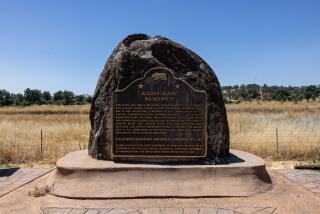The Glory That Was Owensmouth : Canoga Park Celebrates Its Past in Name Only
- Share via
For an area that appears homogenous, many parts of the San Fernando Valley fight bitter battles over what their communities are called.
In recent years, a group of Canoga Park residents fought for the right to be known as West Hills; a North Hollywood area got itself redesignated Valley Village, and a Sepulveda neighborhood is seeking a change to North Hills.
But wrangling over community names is nothing new. It is, in fact, a pastime in the Valley where names have been seen as a factor in developing pride and, perhaps more importantly, raising or lowering property values.
A case in point will be celebrated today when Canoga Park residents gather at the Canoga Owensmouth Historical Museum to observe the 60th anniversary of one such struggle: the three-year effort that transformed the community of Owensmouth to the community of Canoga Park.
But, oddly enough, community leaders are in the dark as to the true origin of the area’s name.
“It’s rather funny, isn’t it?” said Bill Brady, president of the Canoga Park Chamber of Commerce. “It could be anything.”
During the debate about eliminating the name Owensmouth, several conflicting explanations were put forward about the historical significance of the word “Canoga,” but none of them were ever verified as fact.
Some said that “Canoga” was an Indian word meaning “water trough,” a reference to stone-hewn water troughs supposedly carved by local Indians in the 1820s and left in the area for the thirsty horses of the Franciscan missionaries traveling along El Camino Real.
Others claimed the word was a derivation of the Spanish word la canoa, the canoe, a reference to the canoe-like shape of the legendary water-trough’s interior, according to documents provided by the Canoga-Owensmouth Historical Society.
Recent residents suspect that the word Canoga has nothing to do with a water trough at all, and was simply the designation given to the local train station in 1893 by a Southern Pacific Railroad executive, who in all likelihood named it after his daughter.
But they admit that they don’t know for sure.
“The railroad was called Canoga long before the town was started. They say it might have come from a town in New York or it might have been an Indian name, but I have no idea,” said Beth Shirley, founder of the historical society.
The water-trough theory at one point had so convinced community members that when Department of Water and Power workers discovered a huge stone example near the Chatsworth Reservoir in 1933, residents were convinced that this was their namesake.
DWP officials were also convinced that their discovery was an old Indian relic, and they donated it to Olvera Street, then considered a repository for local history.
Outraged that a piece of their history would be callously given to a neighborhood nearly 30 miles away, Canoga Park leaders launched a furious battle against Olvera Street merchants to regain the relic, and several local candidates for public office from Canoga Park promised that if they were elected, they would ensure the trough’s return.
The feud lasted about 30 years, until a reporter from a local newspaper wrote a three-part series on the conflict.
Through her investigation, the reporter discovered that the trough had not been carved by Indians at all, but rather by German immigrant August Schweikhard after he moved to the area in the 1890s and began ranching on land near the reservoir.
Despite the discovery of the Olvera Street trough’s true origins, many old-time Canoga Park residents still clung tenaciously to the theory--never proven--that their name referred to the legendary troughs.
What we do know about the community name change is that by 1928, residents of Owensmouth township had grown disillusioned with the name of Owensmouth--which had been selected 16 years earlier by Times publisher Harrison Gray Otis, one of the five directors of a powerful syndicate that bought up vast tracts of Valley farmland and then divided them into grids and lots for homes.
Otis had picked the name Owensmouth because he felt that the reference to the Owens River would conjure up images of water and fertile land and help the Los Angeles Suburban Homes Co. sell property in the new town.
Otis also believed that the addition of “mouth” made the name “resonant with Anglo-Saxon echoes of English and New England towns such as Falmouth, Plymouth, and Yarmouth,” wrote Catherine Mulholland, granddaughter of engineer William Mulholland, who built the aqueduct that changed the course of the river and Los Angeles history.
But to the refined ears of the local community, it sounded vulgar.
Led by socialite Mary Logan Orcutt, the Owensmouth Woman’s Club began a campaign to obliterate the name.
“When I found myself in Owensmouth, I had no thrill except of embarrassment as I wrote the word at the top of a letter or spelled it for a disdainful young lady from whom I had purchased something in a Los Angeles department store,” area resident Agnes Ralph complained in a 1931 woman’s club newsletter.
“Who was Owen anyway?” she wrote, “and why did I seem to live in his mouth?”
The Southern Pacific Railroad had designated the station built in the area in 1893 as the “Canoga” station, and Woman’s Club members decided that the town’s name should be officially switched to Canoga. Most believed the prevailing legend that railroad executives had named the station after the water troughs.
That was never proven, but community members accepted it as fact and eagerly pursued the change, arguing also that Canoga was simply more “euphonious” than Owensmouth.
In 1931, the Woman’s Club was notified that the U.S. Post Office would allow the change if they added “Park” to the name, so as not to be confused with Canoga, N.Y.
Residents celebrated the change with great joy, for as the Owensmouth Gazette had written in an October, 1930, editorial endorsing the change, the area would now be, like the rest of the San Fernando Valley, “ready for the prosperity now on the way without having to overcome the handicap of a name calling forth unfavorable comment.”
More to Read
Sign up for Essential California
The most important California stories and recommendations in your inbox every morning.
You may occasionally receive promotional content from the Los Angeles Times.










